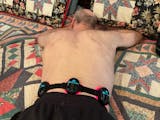Red light therapy has become a popular choice for alleviating inflammation and associated pain. This innovative therapeutic approach, discovered by NASA researchers in the 1990s during experiments aimed at enhancing plant growth, has since shown promise in improving wound healing.
In the realm of red light therapy, specific wavelengths of red and infrared light are directed onto the targeted area. This non-invasive treatment is believed to stimulate mitochondria, the crucial subcellular organelles responsible for energy production within every cell. Additionally, the therapeutic application of red light is thought to contribute to the suppression of inflammation, making it a valuable method for managing pain and promoting overall well-being.
What is Inflammation?
Inflammation is a complex biological response that the body initiates as a protective mechanism in response to harmful stimuli, such as infections, injuries, or irritants. The primary purpose of inflammation is to eliminate the cause of cell injury, clear out damaged cells and tissues, and initiate tissue repair. It is a crucial part of the body's immune response and plays a key role in maintaining overall health.
The inflammatory process involves a series of events orchestrated by the immune system. When the body recognizes a threat, white blood cells, immune cells, and various signaling molecules work together to mount a defense. Blood vessels widen to allow increased blood flow to the affected area, leading to redness and warmth. Capillaries become more permeable, causing swelling, and immune cells migrate to the site of injury or infection to neutralize the threat.
Symptoms of Inflammation
Redness (Rubor)
Increased blood flow to the affected area causes redness. This is a result of blood vessels dilating to allow more immune cells to reach the site of injury or infection.
Swelling (Tumor)
Increased permeability of blood vessels leads to the accumulation of fluid in the tissue, causing swelling. Edema helps isolate the affected area and facilitates the movement of immune cells.
Heat (Calor)
Vasodilation, or the widening of blood vessels, contributes to increased blood flow, creating warmth in the affected area. This is often noticeable to the touch.
Pain (Dolor)
Inflammation can stimulate nerve endings, leading to pain. Pain is a protective mechanism that discourages the use of the affected area, allowing for healing.
Loss of Function
In severe cases, inflammation may lead to a loss of function in the affected area. This can result from pain, swelling, or tissue damage that impairs normal function.
Fever
Systemic inflammation, especially in response to infections, can trigger the release of chemicals that raise the body's temperature. Fever is a common response to inflammation and helps the body combat certain pathogens.
Fatigue
The body's energy resources may be redirected to support the immune response during inflammation, leading to feelings of fatigue and lethargy.
Headache
Systemic inflammation can affect the central nervous system, leading to headaches. This is particularly common in conditions where inflammation is widespread.
Loss of Appetite
Inflammatory mediators can influence appetite-regulating hormones, leading to a reduced desire to eat. This is part of the body's response to redirect energy toward the immune system.
Joint Stiffness
Inflammation in the joints, as seen in conditions like arthritis, can result in stiffness and reduced range of motion.
How Might Red Light Therapy Help Inflammation?
Mitochondrial Stimulation
Red light therapy involves the use of specific wavelengths of red and near-infrared light. These wavelengths are thought to penetrate the skin and stimulate mitochondria, the energy-producing organelles within cells. Enhanced mitochondrial function may contribute to the regulation of cellular processes, including those involved in inflammation.
Anti-Inflammatory Effects
Scientific studies, such as "Photobiomodulation in Inflammatory Diseases: Emerging Mechanisms and New Therapeutic Opportunities," indicate that red light therapy can have anti-inflammatory effects. It may reduce the production of pro-inflammatory cytokines, molecules that play a key role in the inflammatory response, while promoting the release of anti-inflammatory cytokines.
Suppression of Inflammatory Mediators
Red light therapy may help suppress the activity of specific inflammatory mediators, such as nuclear factor-kappa B (NF-κB). NF-κB is a protein complex that plays a central role in regulating the immune response and inflammation. Modulating NF-κB activity could contribute to the overall dampening of inflammation.
Enhanced Tissue Repair
By promoting cellular function and energy production, red light therapy may enhance tissue repair processes. This can be particularly beneficial in the context of inflammatory conditions where tissue damage is a significant component.
Improved Blood Circulation
Red light therapy has been associated with improved blood circulation. Enhanced circulation facilitates the delivery of oxygen and nutrients to tissues, supporting the healing process and potentially reducing inflammation.
Immune System Modulation
Red light therapy may influence the immune system by modulating the activity of immune cells. This modulation can lead to a more balanced immune response, preventing excessive inflammation.
Reduction of Oxidative Stress
Inflammation is often associated with increased oxidative stress, which can contribute to tissue damage. Red light therapy has been suggested to have antioxidant effects, helping to counteract oxidative stress and mitigate its inflammatory effects.
Prungo Red Light Therapy Devices
In the ever-evolving landscape of health and wellness, Prungo emerges as a beacon of innovation with its cutting-edge Red Light Therapy Devices. Harnessing the power of scientifically-backed technology, Prungo is dedicated to providing advanced solutions for individuals seeking holistic well-being. Let's delve into the features and benefits that make Prungo Red Light Therapy Devices stand out in the realm of light-based therapeutic interventions.
















Share:
21 Benefits of Red and Infrared Light Therapy According to Science
Unlocking the Potential of Low-Level Laser Therapy (LLLT) in Bone Health